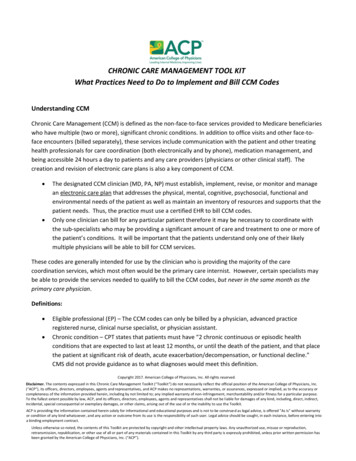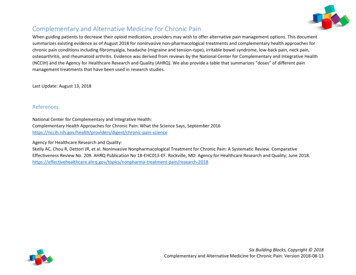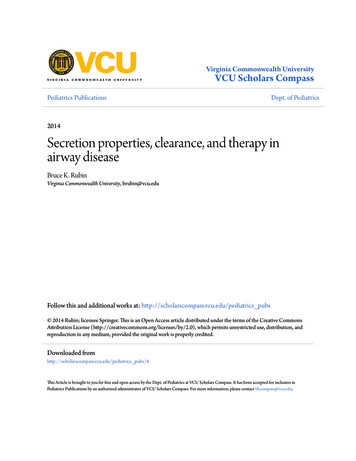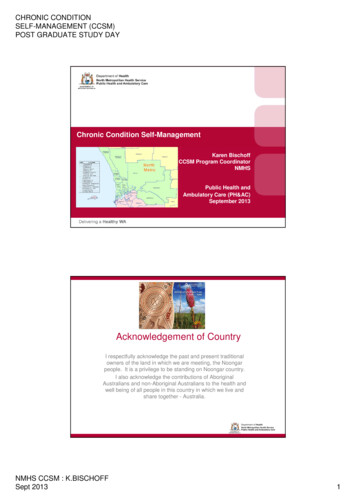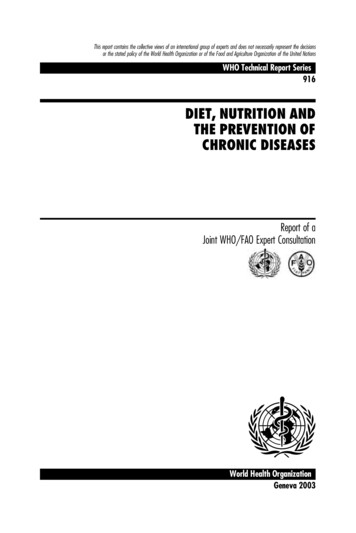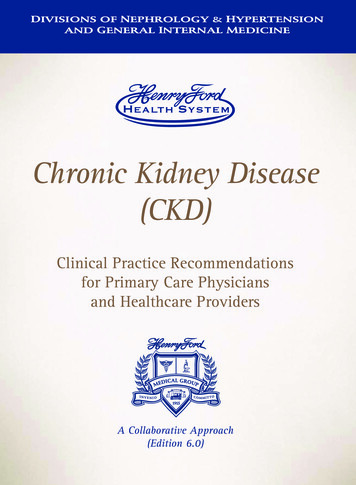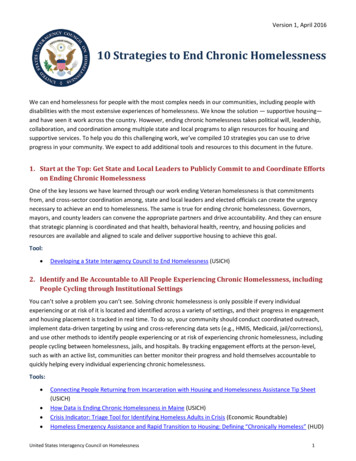
Transcription
Version 1, April 201610 Strategies to End Chronic HomelessnessWe can end homelessness for people with the most complex needs in our communities, including people withdisabilities with the most extensive experiences of homelessness. We know the solution — supportive housing—and have seen it work across the country. However, ending chronic homelessness takes political will, leadership,collaboration, and coordination among multiple state and local programs to align resources for housing andsupportive services. To help you do this challenging work, we’ve compiled 10 strategies you can use to driveprogress in your community. We expect to add additional tools and resources to this document in the future.1. Start at the Top: Get State and Local Leaders to Publicly Commit to and Coordinate Effortson Ending Chronic HomelessnessOne of the key lessons we have learned through our work ending Veteran homelessness is that commitmentsfrom, and cross-sector coordination among, state and local leaders and elected officials can create the urgencynecessary to achieve an end to homelessness. The same is true for ending chronic homelessness. Governors,mayors, and county leaders can convene the appropriate partners and drive accountability. And they can ensurethat strategic planning is coordinated and that health, behavioral health, reentry, and housing policies andresources are available and aligned to scale and deliver supportive housing to achieve this goal.Tool: Developing a State Interagency Council to End Homelessness (USICH)2. Identify and Be Accountable to All People Experiencing Chronic Homelessness, includingPeople Cycling through Institutional SettingsYou can’t solve a problem you can’t see. Solving chronic homelessness is only possible if every individualexperiencing or at risk of it is located and identified across a variety of settings, and their progress in engagementand housing placement is tracked in real time. To do so, your community should conduct coordinated outreach,implement data-driven targeting by using and cross-referencing data sets (e.g., HMIS, Medicaid, jail/corrections),and use other methods to identify people experiencing or at risk of experiencing chronic homelessness, includingpeople cycling between homelessness, jails, and hospitals. By tracking engagement efforts at the person-level,such as with an active list, communities can better monitor their progress and hold themselves accountable toquickly helping every individual experiencing chronic homelessness.Tools: Connecting People Returning from Incarceration with Housing and Homelessness Assistance Tip Sheet(USICH)How Data is Ending Chronic Homelessness in Maine (USICH)Crisis Indicator: Triage Tool for Identifying Homeless Adults in Crisis (Economic Roundtable)Homeless Emergency Assistance and Rapid Transition to Housing: Defining “Chronically Homeless” (HUD)United States Interagency Council on Homelessness1
Version 1, April 2016 The Office of Community Oriented Policing Services (COPS) Newsletter Volume 8 Issue 12: Breaking theCycle of Homelessness (DOJ)NYC FUSE Evaluation: Decreasing Costs and Ending Homelessness (CSH)Permanent Supportive Housing Resource Guide: Chapter 7 (VA)3. Ramp up Outreach, In-reach, and Engagement EffortsPersistent, coordinated, and creative outreach efforts — and in-reach into institutional settings — are vitallyimportant to the ability to not only identify, but engage, people experiencing chronic homelessness and link themto the housing and services interventions available in your community. That involves: Ensuring that outreach efforts are comprehensive — covering a full geographic area and the multiplesettings within it — and coordinated across all teams and providersSharing information across outreach teams and sites, and coordinated with other systems, including lawenforcement, hospitals and emergency departments, prisons and jails, libraries, and job centersPartnering with Health Care for the Homeless (HCH) grantees and Projects for Assistance in Transitionfrom Homelessness (PATH) grantees who can have a powerful impact on improving care coordinationand optimizing resourcesPartnering with law enforcement, prisons, jails, and hospitals to conduct both in-reach and outreach toreduce the cycle between homelessness and criminal justice system involvementThese efforts should seek to reach and connect with all people who are unsheltered within your community,including people living in encampments or tent cities, as well as people in institutional settings, such as jails andhospitals. All outreach should be person-centered and emphasize building rapport and trust as a means of helpingpeople obtain housing with appropriate services.Tools: Ending Homelessness for People Living in Encampments: Advancing the Dialogue (USICH)We Can Break the Cycle of Homelessness and Criminal Justice System Involvement (USICH)Assessing the Evidence: What We Know About Outreach and Engagement (SAMHSA)Projects for Assistance in Transition from Homelessness (PATH) Resource Page: Outreach (SAMHSA)National Health Care for the Homeless Council: Outreach Resources (NHCHC)Law Enforcement is a Critical Component of the Coordinated Effort to End Homelessness (DOJ)4. Implement a Housing-First System Orientation and ResponseCommunities must adopt a Housing First approach across their entire system to ensure that people with complexneeds can exit homelessness as quickly as possible. To drive such transformation, communities should adoptuniform measures of success that emphasize permanent housing, with the right level of services, as the goal forpeople experiencing chronic homelessness. Other strategies include: Reducing or removing barriers for applicants with substance use issues, poor credit or financial history, orpast involvement with the criminal justice systemCoordinating with legal services organization to address individual and systemic legal needs of peopleexperiencing chronic homelessnessCreating strong and direct referral linkages and relationships between the crisis response system — localshelters, outreach programs, hospitals, police departments, etc. — and supportive housingUnited States Interagency Council on Homelessness2
Version 1, April 2016 Ensuring that all staff in shelters, outreach teams, and housing settings are trained that substance use,criminal histories, or motivation are not obstacles to successful tenancy in housingTools: Housing First Checklist: A Practical Tool for Assessing Housing First in Practice (USICH)Implementing Housing First in Permanent Supportive Housing (USICH)Landlord Engagement Resources (USICH)Housing First in Permanent Supportive Housing Brief (HUD)Legal Aid Interagency Roundtable Toolkit (DOJ)5. Set and Hold Partners Accountable to Ambitious Short-Term Housing Placement GoalsMany communities have established ambitious monthly, quarterly, or 100-day housing placement efforts,sometimes called housing placement “surges,” to break down the larger goal of ending chronic homelessness intofocused blocks of time and effort, while pushing their systems to perform with maximum efficiency and betteroutcomes. These goals can be met by: Creating and sharing a community-wide list of people experiencing chronic homelessnessUsing a tested and validated assessment tool and process to prioritize and target interventionsUsing navigators and/or guides to address individual’s needsMonitoring progress rooted in access to housing on a weekly or monthly basisTools: Connecticut Launches 100-Day Effort to End Homelessness (USICH)A Sea Change in Fresno’s Homelessness Crisis Response (USICH)Coordinated Entry System to End Veteran and Chronic Homelessness in Tucson (USICH)6. Prioritize People Experiencing Chronic Homelessness in Existing Supportive HousingIn many communities, the supportive housing opportunities that have been created have unfortunately not beenwell targeted. In fact, national data shows that only about 29% of existing supportive housing is targeted toindividuals experiencing chronic homelessness. You can maximize the impact of existing supportive housing byadopting a policy that prioritizes individuals experiencing chronic homelessness for any newly created units, andfor any units that become available through turnover, unless there are no longer any individuals experiencingchronic homelessness remaining.Coordinated entry is a critically important approach for prioritizing and matching people experiencinghomelessness to the most appropriate housing and services. Within coordinated entry systems, communities canuse data-driven approaches to prioritize people experiencing chronic homelessness who have the most significantneeds for housing and services.Tools: Notice on Prioritizing Persons Experiencing Chronic Homelessness and Other Vulnerable HomelessPersons in Permanent Supportive Housing (HUD)Permanent Supportive Housing Resource Guide (VA)Coordinated Entry Policy Brief (HUD)United States Interagency Council on Homelessness3
Version 1, April 2016 Lessons Learned from Developing Coordinated Entry Systems: Richmond and Los Angeles (USICH)Homeless Emergency Assistance and Rapid Transition to Housing: Defining “Chronically Homeless” (HUD)Final Chronic Definition Adds Flexibility, Inclusiveness, and Specificity (USICH)7. Project the Need for Additional Supportive Housing and Reallocate Funding to Take It tothe Scale NeededTo end chronic homelessness, communities must have an adequate supply of supportive housing to assistindividuals who are currently experiencing chronic homelessness and those who are likely to be chronicallyhomeless in the near future. Some communities can make significant progress toward the goal just by improvingthe targeting of existing units. Most communities will also need to expand their supportive housing inventorythrough maximizing both targeted grants and leveraging new mainstream resources. The degree to whichresources meet this current and future need will vary from community to community. A good starting point is touse data to assess whether your community has a gap in supportive housing availability, and if so, to determinethe size of that gap.To expand the supply of supportive housing, communities can also monitor the performance and costeffectiveness of programs within their homelessness service system and reallocate funds to the programs with thebest outcomes. Reallocating funds is one of the most important tools by which communities can make strategicimprovements to their system for ending homelessness.Tools: Supportive Housing Opportunities Planner (SHOP) Tool (USICH)Creating Effective Systems to End Homelessness: A Guide to Reallocating Funds in the CoC Program(USICH)Services in the COC Program: A Guide to Assessing Value and Finding Funding Alternatives (USICH)8. Engage and Support Public Housing Agencies and Multifamily Affordable HousingOperators to Increase Supportive Housing through Limited Preferences and ProjectBased VouchersBy partnering with public housing agencies and operators of HUD-financed multifamily housing, communities canexpand the supply of supportive housing, as well as create new housing opportunities for current residents ofsupportive housing. Specifically, PHAs and operators of multifamily housing can: Establish a limited preference, committing Housing Choice vouchers, public housing units, and multifamilyhousing units to serve people experiencing chronic homelessness, which communities can couple withsupportive servicesUse project-based Housing Choice vouchers within apartment buildings being developed to serve assupportive housingIncrease opportunities for tenants of supportive housing who do not need the intensity of servicesprovided to "move up" through Housing Choice vouchers and other affordable housing and employmentservices, freeing up supportive housing opportunities for people experiencing chronic homelessness.Tools: PHA Guidebook to Ending Homelessness (USICH)United States Interagency Council on Homelessness4
Version 1, April 2016 Resources to Support Partnerships between CoCs and PHAs (HUD)CoC and PHA Collaboration: Strategies for CoCs to Start the Partnership Conversation (HUD)Opening Doors Through Multifamily Housing: Toolkit for Implementing a Homeless Preference (HUD)9. Leverage Medicaid and Behavioral Health Funding to Pay for Services in SupportiveHousingSupportive housing combines affordable housing with a tailored package of supportive services that help peopleachieve housing stability. Implementing successful supportive housing requires consistent and effectivesupportive services, which in turn require reliable and sustainable funding. One of the most promising sources ofsustainable financing for these services is Medicaid.As federal guidance has clarified, states have the option of ensuring their Medicaid plans cover housing-relatedand supportive services that help people find and keep their housing and connect to care. States can supplementMedicaid with behavioral health system funding, such as mental health and substance abuse prevention andtreatment block grants. By leveraging Medicaid and behavioral health funding for supportive services,communities can shift HUD funding toward providing rental assistance for additional units.Tools: Primer on Using Medicaid for People Experiencing Chronic Homelessness and Tenants in PermanentSupportive Housing (HHS)Information Bulletin on Coverage of Housing-Related Activities and Services for Individuals withDisabilities (HHS)Services in the CoC Program: A Guide to Assessing Value and Finding Funding Alternatives (USICH)A Quick Guide to Improving Medicaid Coverage for Supportive Housing Services (USICH, CSH)Medicaid and Permanent Supportive Housing: A Quick Guide for Health Centers (USICH, NHCHC)10. Help People Increase Their Income through Employment Opportunities and Connectionsto Mainstream Benefits and Income SupportsBy combining affordable housing with supportive services, employment opportunities, and income supports,communities can help individuals with disabilities achieve stability and independence. A critical way to providethat stability is by connecting eligible people experiencing chronic homelessness to Supplemental Security Income(SSI) and Social Security Disability Insurance (SSDI) benefits, and by increasing income through connections toemployment opportunities and workforce programs. Health and behavioral health care services and supports, andother supportive services, are also essential for promoting health and long-term housing stability.Tools: Key Strategies for Connecting People Experiencing Homelessness to SSI/SSDI Benefits (USICH, SSA,SAMHSA, and VA)SSI/SSDI Outreach Access and Recovery Portal (SAMHSA)Partnerships for Opening Doors: A Summit on Integrating Employment and Housing Strategies to Preventand End Homelessness (USICH, DOL, HUD)United States Interagency Council on Homelessness5
You can’t solve a problem you can’t see. Solving chronic homelessness is only possible if every individual experiencing or at risk of it is located and identified across a variety of settings, and their progress in engagement and housing placement is tracked in real time. To d
